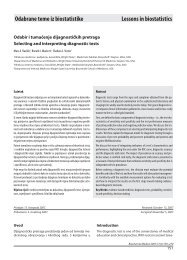Posterske teme Poster topics - Biochemia Medica
Posterske teme Poster topics - Biochemia Medica
Posterske teme Poster topics - Biochemia Medica
Create successful ePaper yourself
Turn your PDF publications into a flip-book with our unique Google optimized e-Paper software.
P17-4 Imunologija<br />
P17-4<br />
Imunofenotipizacija stanica citološkog<br />
punktata metodom protočne citometrije<br />
Kardum-Paro MM 1 , Šiftar Z 1 , Šiftar Z 1 , Kardum-Skelin I 2 , Šušterčić D 2 ,<br />
Flegar-Meštrić Z 1 , Jakšić B 1<br />
1 Zavod za kliničku kemiju, KB Merkur, Zagreb, Hrvatska<br />
2 Klinika za unutarnje bolesti, KB Merkur, Zagreb, Hrvatska<br />
Citološki punktat limfnog čvora predstavlja suspenziju<br />
stanica, ali i nerutinski, specifi čan heterogeni analitički<br />
uzorak čija je primjena u dijagnostici limfadenopatija najčešće<br />
ograničena nedostatnim brojem stanica uzorka. Cilj<br />
je bio analitički i dijagnostički evaluirati metodu protočne<br />
citometrije, odrediti prikladnost citološkog punktata<br />
limfnog čvora za analizu, ocijeniti učinkovitost literaturnih<br />
graničnih vrijednosti omjera lakih lanaca, a moguće<br />
latentne povezanosti prikazati matematičkim modelom.<br />
Citološki punktati limfnog čvora (n=245) dobiveni aspiracijom<br />
analizirani su metodom protočne citometrije u<br />
Zavodu za kliničku kemiju KB Merkur potvrđenom prema<br />
međunarodnom standardu ISO:9001:2000. Analitičkom<br />
procjenom (prema preporukama Instituta za kliničko- laboratorijske<br />
standarde NCCLS) je određena nepreciznost,<br />
netočnost, linearnost i donja granica detekcije. Dijagnostička<br />
osjetljivost i specifi čnost, pozitivna (PPV) i negativna<br />
(NPV) prediktivna vrijednost metode protočne citometrije<br />
su određene eksplorativnom statistikom neuronske<br />
mreže programske potpore Statistica Version 6. Klasifi -<br />
kacijom podataka metodom stabla odlučivanja izgrađen<br />
je matematički model predviđanja dijagnoze. Kontrola<br />
ispravnosti optičkog i protočnog sustava citometra, kvalitete<br />
reagensa, monoklonskih protutijela i specifi čnih analitičkih<br />
uvjeta bila je dio unutarnje kontrola kvalitete. Za<br />
kontrolu pouzdanosti analitičkih rezultata primijenjena<br />
je međunarodna nezavisna procjena rezultata UKNEQAS.<br />
Prema kriteriju odgovarajućeg broja leukocita (0,35x10 9 /<br />
L) iz analize su izuzeta 72 (22%) citološka punktata. Nepreciznost<br />
mjernog instrumenta je iznosila do 7%, a netočnost<br />
do 10%. Određena je dijagnostička osjetljivost<br />
(82%), specifi čnost (72%), PPV (93%) i NPV (48%) metode<br />
protočne citometrije. Primjena jačeg kriterija određivanja<br />
klonalnosti limfocita B smanjila je osjetljivost, a povećala<br />
specifi čnost metode. Pouzdanost analitičkih rezultata<br />
potvrđena je zadovoljenjem svih međunarodnih kriterija<br />
prihvatljivosti. Zaključeno je kako standardizacija metode<br />
protočne citometrije prema radnim protokolima osigurava<br />
pouzdanost analitičkih rezultata u citološkom punktatu<br />
limfnog čvora. Potencijalna primjena i učinkovitost<br />
<strong>Biochemia</strong> <strong>Medica</strong> 2006;16(Suppl 1):S1–S268<br />
S192<br />
P17-4<br />
Immunology<br />
Immunophenotyping of fi ne needle aspirate<br />
cells by fl ow cytometry method<br />
Kardum-Paro MM 1 , Šiftar Z 1 , Šiftar Z 1 , Kardum-Skelin I 2 , Šušterčić D 2 ,<br />
Flegar-Meštrić Z 1 , Jakšić B 1<br />
1Department of Clinical Chemistry, Merkur University Hospital, Zagreb,<br />
Croatia<br />
2University Department of Medicine, Merkur University Hospital,<br />
Zagreb, Croatia<br />
Fine-needle aspirate (FNA) represents a suspension of<br />
lymph node cells but also a nonroutine, specifi c and<br />
heterogeneous analytical specimen the use of which is<br />
usually limited by the inadequate number of cells for the<br />
fl ow cytometry method (FCM). The aim of the study was<br />
to perform critical analytical and diagnostic evaluation<br />
of FCM, to assess the adequacy of FNA for FCM analysis,<br />
to evaluate the usefulness of the light chain ratio borderline<br />
values reported in the literature, and to present<br />
the possible associations as a mathematical model. Upon<br />
collection, 245 FNA specimens were analyzed by FCM at<br />
Department of Clinical Chemistry, Merkur University Hospital,<br />
certifi ed according to ISO:9001:2000. Brief analytical<br />
evaluation (imprecision, inaccuracy, linearity and lower<br />
detection limit) was done according to the evaluation<br />
guides of the Clinical and Laboratory Standards Institute<br />
(NCCLS). Diagnostic specifi city and sensitivity as well as<br />
positive (PPV) and negative (NPV) predictive value of the<br />
FCM were determined using explorative statistics of the<br />
neural network (Statistica Version 6). Using the classifi -<br />
cation tree method for the classifi cation of input data, a<br />
mathematical model of diagnosis prediction was generated.<br />
The instrument quality control assurance of the optic<br />
and fl uid system, reagents and monoclonal antibodies<br />
as well as specifi c analytical control were performed.<br />
The reliability of our analytical results was evaluated by<br />
UKNEQAS independent international external quality<br />
control. According to the criteria of FNA leukocyte count<br />
(0.35x10 9 /L), 72 (22%) FNA specimens were excluded from<br />
further analysis. For all parameters of the instrument<br />
(Coulter EPICS-XL), imprecision and inaccuracy were 7%<br />
and 10%, respectively. Diagnostic sensitivity, specifi city,<br />
PPV and NPV for FCM were 82%, 72%, 93% and 48%,<br />
respectively. The use of the literature light chain ratio<br />
borderline values reduced diagnostic sensitivity but increased<br />
diagnostic specifi city of FCM. Standardization of<br />
FCM in nonroutine, specifi c and heterogeneous analytical<br />
specimens like FNA is possible due to the sample preparation<br />
protocols and instrument quality control assurance.<br />
In routine classifi cation of new data, the use of the gener-






